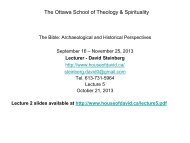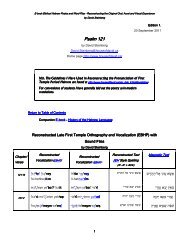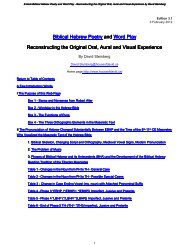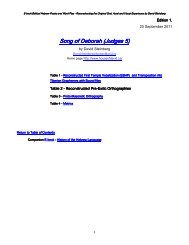terms, abbreviations, and linguistic symbols - David Steinberg's ...
terms, abbreviations, and linguistic symbols - David Steinberg's ...
terms, abbreviations, and linguistic symbols - David Steinberg's ...
You also want an ePaper? Increase the reach of your titles
YUMPU automatically turns print PDFs into web optimized ePapers that Google loves.
EEEE----book book book book Biblical Biblic Biblic Biblical<br />
al al Hebrew Hebrew Hebrew Hebrew Poetry Poetry Poetry Poetry <strong>and</strong> <strong>and</strong> <strong>and</strong> <strong>and</strong> Word Word Word Word Play Play Play Play ---- Reconstructing Reconstructing Reconstructing Reconstructing the the the the Original Original Original Original Oral, Oral, Oral, Oral, Aural Aural Aural Aural <strong>and</strong> <strong>and</strong> <strong>and</strong> <strong>and</strong> Visual Visual Visual Visual Experience<br />
Experience Experience<br />
Experience by by by by <strong>David</strong> <strong>David</strong> <strong>David</strong> <strong>David</strong> Steinberg Steinberg Steinberg Steinberg<br />
39 See Archaic or Archaizing Poetic Texts.<br />
40 See Young, Rezetko, Ehrensvärd 2008 chapt. 12; Vern 2008.<br />
41 See Sáenz-Badillos §3.3; Kutscher 1982 p. 79 ff.<br />
42 From Young, Rezetko, Ehrensvärd 2008 p. 57.<br />
(W)e agree with Hurvitz that it is impossible to discern <strong>linguistic</strong> development within EBH (my CBH) or<br />
within LBH (my PCBH).... For example, on the basis of language, we cannot date alleged preexilic EBH<br />
texts to the tenth as opposed to the seventh century, nor can we date possible sources within supposed<br />
preexilic books, such as Genesis or Samuel, to particular points in time. More explicitly, alleged preexilic<br />
EBH texts written over a potential span of hundreds of years (eg. 1000-600 BCE) do not reflect any<br />
discernible chronological <strong>linguistic</strong> variations.<br />
43 See Ehrenbsvärd 2004. . . The following is quoted from Kofoed 2006 pp. 98-99 -<br />
If there is ever any truly sharp division between two historical stages of a language over a relatively short<br />
time period, then it is an accident. Catastrophic change in language is not the norm. Current theory<br />
rebuts, therefore, the argument (often stated ex silentio) that only one kind of Hebrew was being used at<br />
any one time, <strong>and</strong> Davies is therefore right in arguing that one cannot automatically convert <strong>linguistic</strong><br />
typology into <strong>linguistic</strong> chronology. A range of synchronic factors must be taken into consideration before<br />
a diachronic explanation can be settled: dialect, colloquial language, idiolect, sociolect, archaizing<br />
language, etc. This is also true for periods where such differing grammars are unattested in the written<br />
sources. Since writing is secondary to speech, vernaculars <strong>and</strong> dialects must by necessity have existed<br />
alongside the written Hochsprache. Before jumping to diachronic explanations of <strong>linguistic</strong> difference one<br />
must acknowledge, therefore, that the dark side of the moon is just as real as the visible, <strong>and</strong> that the<br />
existence of additional contemporary grammars may account better for the <strong>linguistic</strong> differences than<br />
diachronic ones.<br />
Furthermore, since language change is influenced by a number of unpredictable factors (time, society,<br />
<strong>and</strong> the individual) no linear development can be ascribed automatically to any language. Modern<br />
<strong>linguistic</strong> theory has, for the same reason, dismissed the idea that language change is governed by an<br />
internal "biological clock" that makes it possible for the historical linguist to reconstruct prior stages <strong>and</strong> to<br />
predict future developments of a given language....<br />
44 From Kofoed 2006 p. 103 -<br />
The obvious choice of a comparative case study would of course be to pick a well-documented<br />
contemporary <strong>linguistic</strong> case in the same literary genre <strong>and</strong> from the same cultural stream. The closest<br />
match in that regard is probably the Babylonian "literary" language or "St<strong>and</strong>ard Babylonian," which<br />
remained so stable that even distinguished scholars erroneously dated compositions late that later were<br />
proved to stem from Old Babylonian times.<br />
18








